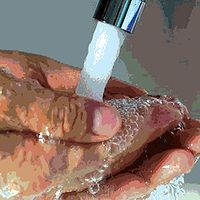It has been proven time and time again that handwashing plays a key role in both personal health and food safety in food manufacturing and foodservice/retail operations. Despite the obvious benefits of this seemingly straightforward task, two concerns continue to stand out: Food handlers not washing hands frequently enough or not washing hands effectively.
The art of handwashing could easily be mistaken for a mere trivial action that requires little attention. Nothing could be further from the truth! In all actuality good hygienic hand practices are so important they warrant the food industry’s perpetual focus. Simply put, we should remember the basic who, what, when, where and whys of handwashing in order to develop the best practices we need to commuicate the “how.”
What & Why?
According to Handwashing For Life, poor handwashing plus poor gloving now add up to the number one risk factor in foodborne illness (www.handwashingforlife.com). The nationally recognized organization, which is devoted to advancing the science of hand hygiene to reduce foodborne illness, states that since the the fecal-hand-oral route of food contamination represents the most common source of foodborne illness, solving the problem of poor hand hygiene in public and employee restrooms is critical to reducing risk. Breaking this chain of contamination, says the group, is the first major action to lowering risk.
Indeed, a large number of illnesses could be prevented if more people followed stricter handwashing hygiene protocols. Frequent and effective handwashing removes bacteria and microorganisms from the surface of our hands. Once these potentially harmful substances are on the hands, it becomes easy for a person to transfer them to the mouth, eyes and nose if touched—places through which they can enter the body and cause illness to occur.
In addition, viruses pose a particularly significant threat with regard to handwashing, in that they are often found on the surface of the human body and require a host cell to survive and reproduce. Because viruses can be transferred from person to food and between people, handwashing is critical. It prevents the spread of foodborne illnesses and other sicknesses. Ultimately, it reduces both the risk of a food handler or preparer spreading bacteria to product and potentially becoming infected with a virus themselves.
Who?
All of us, working in the food industry or not, would agree that no one is exempt from handwashing. Everyone should wash their hands with some frequency. Since handwashing is the single most important aspect of personal hygiene, it is not surprising that it is a major concern. Food handlers have the biggest responsibility for washing their hands. One would expect that extreme caution should be taken upon preparing food that others will consume. People place a large amount of trust when it comes to letting someone else prepare their food. Restaurant guests and the general public expect that the foods they consume will have been prepared under sanitary conditions, as well as by food handlers who follow good personal hygiene practices.
In order for handwashing to be effective, however, it requires two-way participation. In the same way that foodservice personnel must wash their hands, consumers must do the same. For example, it does not make much difference if you eat food prepared by someone who has washed their hands if you do not do the same prior to eating. During the course of a day, we primarily use our hands to access practically what ever it is we want in the world. Our environment consists of many things that could contaminate our hands, ultimately leading to poor health. As an industry, we must find good ways to help educate consumers about their role in good hand hygiene practices, as a supplement to educating personnel in handwashing and other personal hygiene best practices.
When?
In general, there are specific times when everyone should be washing their hands, the most obvious and the most critical time being after using the restroom. Many illnesses (specifically the virus hepatitis A) are caused by bacteria being transferred via the fecal-oral route. It is absolutely imperative that efficient handwashing take place after using the restroom. Other instances when handwashing should occur include after eating, drinking, smoking, coughing or sneezing. Any time hands come in contact with the mouth, complete and thorough handwashing should follow. Touching trash or anything that might be dirty, such as equipment, dishes or cleaning supplies also warrants handwashing before handling food or touching food-contact surfaces. It is important for personnel in the food industry to wash hands after cleaning dirty utensils and surfaces, as well, since these common items can be a source of contamination.
It is expected that food handlers will engage in washing their hands more frequently than someone whose duties do not necessarily involve direct food contact. Individuals whose jobs do require the direct contact with foods should wash their hands before beginning work. As a general rule, while working with food, hands should be washed every hour. Recently, some companies have gone as far as using documentation to verify that employees do wash their hands hourly. The primary focus here is that in a food service or food processing environment employees wash their hands with some predetermined frequency. As always, it is mandatory to wash hands before and after preparing raw meats, especially poultry.
It is also generally understood that hands should be washed after changing gloves. Gloves can create a false since of security and cause one to believe that the hands are clean. In some instances however, it is deemed acceptable to use bare hands during preparation of non ready to eat foods. This actually creates a benefit because food handlers are more likely to wash their hands in an effort to remove the food residue left behind during preparation.
Where?
Where hands are washed can be just as significant as the actual practice. Handwashing should be limited to certain designated areas called handwashing stations. These handwashing sinks should be kept clean and in good working order. Washing hands in a dirty sink could be ineffective if it leads to further contamination. Handwashing stations should also be equipped with hand soap approved for use in food establishments, as well as an FDA approved hand antiseptic. These alcohol-based solutions must be placed in dispensers only located in handwashing stations. If hand sanitizers are placed far away from hand sinks, it might tempt people to use them without washing hands. Hand sanitizers should only be used after handwashing, and never as a substitute.
Hand sinks should have water at least 100F. Handwashing stations should always be equipped with an abundant supply of paper towels in order to dry hands.
How?
As children, handwashing is perhaps one of the first facets of personal hygiene that we learn and are able to carry out on our own. You may have heard that you should wash your hands for the duration of the time it takes to recite alphabet or sing the “Happy Birthday” song. The truth of the matter is that whatever the interpretation of the methods, handwashing must above all be effective. There is usually a proven art to doing something consistently and effectively. The same is true for handwashing. Besides actually doing it, the time it takes to wash hands is the most important. If enough time is spent washing hands, there is a greater chance that they will be washed effectively. Each handwashing session should take approximately 25 seconds.
The following simple step-by-step handwashing protocol should be communicated to all personnel in food processing and service environments:
Step 1: Allow running water at least 100F to rinse hands. This pre-rinse should remove most debris from hands and prepare them for soap application.
Step 2: Apply soap and lather hands. This step should occupy the majority of the handwashing session. Scrub hands together and be sure to clean between fingers, under fingernails. It is acceptable to use a nail brush for this step if, and only if, it is kept in good sanitary condition and located inside or near the hand sinks. Bear in mind that during the course of a day many people may use same nail brush. If it is not kept clean, the brush can be a source of contamination itself. Nail brushes are an added benefit but effective handwashing can still be achieved without their use. The forearms often contain as much bacteria as the hands themselves. It is crucial to include washing the forearms during this step.
Step 3: Completely rinse hands. This step is important in that it prepares the hands for the application of the sanitizer. If soap residue is left on the hands the sanitizer may not be effective. Soap may counteract the effects of the sanitizer.
Step 4: Dry your hands. Hands should be dried with single-use paper towels. After drying hands use another clean paper towel to turn of the faucets and open a door if needed. Under no circumstances is it permissible to use a common towel to dry hands after washing.
Step 5: Apply hand sanitizer. Hands should be completely dry before adding the hand antiseptic. After the applying the antiseptic allow hands to air dry.
In reality, theses practices should already be in place. They do, however, require frequent revisiting. As with most issues there should be effective training to verify that the system is continuing to function efficiently. Ultimately, handwashing promotes personal health and reduces risks associated with food safety.
Read sidebars "7 Steps to a Realistic Hand Hygiene Plan" and "Kitchens from Hell: A Study in What Not to Do"
Johnnie Deon Green began working in the food industry in 1999, and was named the Quality Assurance Manager for SWH Custom Foods in Fullerton, CA in 2004. He has served in the areas of production, quality assurance and sanitation in meat processing plants and cook chill food production facilities. During years of service, Green has increased company/industry output and production capacity by effectively managing and streamlining the production process. Functioning in the training arena, Johnnie has overseen training programs that range from development, translation, communication of training materials to employee development and training in both Spanish and English.
Acknowledgment
The author would like to acknowledge and thank Jim Mann and his organization, Handwashing For Life, for providing supplmental materials to this article.
7 Steps to a Realistic Hand Hygiene Plan
If your handwash stations are less than ideal get started on a continuous improvement program. While it is nice to have the latest and best of equipment, great improvements can always be made in handwashing practices using existing facilities more effectively. Often minor changes and/or additions can have a dramatic impact on employee use.
Handwashing For Life recommends the following seven first steps and priorities and food establishment can take to encourage critical handwashing activities:
1. Soap: Eliminate any open top soap dispensers as they can harbor microbes and/or be a source of contamination. Install a closed bag soap dispensing system that comes equipped with a device for counting the number of times it is used. A counter is critical to provide management with a means for establishing and monitoring proper handwash performance.
2. Towels: Wet hands readily transfer pathogens to food, utensils and other surfaces. Eliminate all blow dryer systems from employee handwash stations. Research has demonstrated hot air drying is counter good hand hygiene practices. Select and install single use paper towels that deliver soft, fast, one sheet drying results. Install touch-free towel dispensers (i.e., no levers, buttons, dials to touch).
When a hands-free dispenser is not available, clean the dispensing parts frequently and sanitize with a good surface sanitizer.
3. Hand Sanitizers: Install hand sanitizing stations in kitchen areas where it is not currently practical to install a full handwash station with water and drainage facilities. Also ensure waiter staff have access to hand sanitizing stations at, or near, their workplace.
4. Water: Ideal water is heated to 100F and flowing at a 2 gallon per minute rate. Temperature is critical to encourage frequency of washing; flow is critical for effective washing. Take corrective action if temperature is not comfortable. Also consider hand sanitizer and towel dispenser if warm temperature cannot be delivered to station.
5. Nail Brushes: Often nail brushes harbor more microbes and pathogens than any other appliance in the kitchen. Dispose of high-risk brushes (i.e., wooden based, glued or stapled bristles, chained to sink, etc.) and replace with fused bristle brushes. Send through dishwasher frequently to sanitize.
6. Sinks & Faucets: In an existing operation it is often difficult to replace these basic fixtures. Insure that any renovation takes the best technology into consideration. If you currently have faucets with hand-operated taps or buttons consider replacing with automatic faucets or retrofitting with a hands-free, or low-touch, appliance. At a minumum, try to replace highly grooved taps with smooth surface taps for easy cleaning and sanitizing.
If taps are your only option, ensure surfaces are cleaned regularly and sanitized regularly during the shift. Consider placing a surface sanitizing spray bottle at each handwash station. Teach employees to use hand towels to turn off faucets to prevent cross-contamination.
7. Convenience: A handwash station should be within three to four steps of all workstations in the kitchen. This is difficult to change in an existing facility, but proper design should be a priority in any renovation. Short-term, consider hand sanitizer and towel dispensers in areas underserviced by handwash stations.
Visit handwashingforlife.com to get more specific information.
—Jim Mann, Handwashing For Life Institute
Kitchens from Hell: A Study in What Not to Do
Handwashing For Life’s Finger Tips archive section features a collection of website visitors’ photos designed as a reminder that good intentions can pave the way to hell’s handsinks. “We are confident that acts of maliciousness were not involved in the original installation design and execution,” writes Jim Mann, executive director of Handwashing For Life Institute. “No kitchen designer knowledgeable about food safety would have specified what you are about to see. Some of these handsinks were just plain poorly conceived. Others have likely degenerated over time. Many are likely a response to a local code which often reflects the FDA’s model Food Code—stressing the presence of a handsink, but offering little to guide the specifics and use.”
Terminal Food #1: This busy restaurant at Chicago’s O’Hare Terminal presents quite a few hurdles for potential handwashers among the food handling staff.
Double Blocked Handsink: Temporary storage trumps handwashing. Waiting for the adjacent storage area to be unlocked, a worker drops off a couple cases. Soon after, seeing the handsink is already blocked, another employee places a container of freshly cut vegetables directly on the handsink.
Distant Drying: Although this handsink is crowded by income-producing beverage dispensers, its bigger problem is the location of the paper towels. Wet dripping hands pass over a variety of food contact surfaces including clean glassware.
How Far is Too Far?: “Yes, we have a handsink.” And it is a good one. But its distant location from many key food prep stations minimizes its use. It certainly does little to remind workers to wash their hands.
Source: Handwashing For Life • Finger Tips Archive. 2007.




